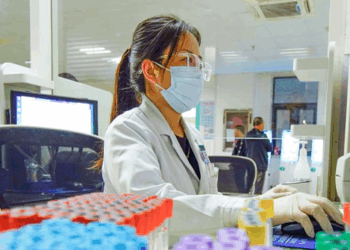The fruits of a real nuclear renaissance are within reach in the United States, and the path involves four pillars symbolized by the Four Harmonious Friends.
Note: This article is part of the Center’s symposium on nuclear energy. To read other articles in the symposium, go here.
Growing up in Asia, I often heard the story of the Four Harmonious Friends: an elephant, a hare, a monkey, and a bird who, by standing on each other’s shoulders, reach fruits that they couldn’t grasp individually. The moral is that cooperation multiplies individual strength. The same lesson applies to the revival of US nuclear power.
After decades of stagnation, the US nuclear industry has been given new momentum, first by the tech industry’s appetite for more data centers, and then by President Trump’s energy dominance agenda. In May 2025, the president signed four executive orders (EOs) to jumpstart civilian nuclear power, with the objectives of strengthening the domestic nuclear industrial base, making the Nuclear Regulatory Commission more efficient, and accelerating the testing and deployment of reactors at Department of Energy sites. A successful nuclear energy revival would not only reinforce US leadership in the global AI race but also position the country more effectively to compete against China and Russia on nuclear technology and in international projects.
The administration has set forth some ambitious goals: begin construction of ten new large reactors by 2030 and quadruple US nuclear capacity by 2050. Both goals look politically appealing given the need for more reliable, affordable, and clean power to feed data centers and industrial activity. Currently, nuclear power accounts for 19 percent of US electricity. Quadrupling this capacity would likely push that share above 50 percent by 2050, a scale of mobilization unseen since the 20-year period between 1970 and 1990, when over 90 GW of capacity was built. The target to commence construction on ten new large reactors within the next five years is more manageable, but even that will test the weakened supply chain and workforce of the US nuclear industry.
The simple fact is that the United States cannot do this alone, and the experience of Vogtle Units 3 and 4 makes that clear. After seven years of delays and nearly $20 billion in cost overruns, the project reveals not just the risks of a first-of-a-kind (FOAK) design but also deeper industry-wide problems in the United States, including supply chain issues, generational skills gaps in its workforce, and poor project management. In the golden age of nuclear power, the United States could rely on a strong industrial base and an ample domestic supply of components like forgings, pumps, and turbines. The nation not only enjoyed plenty of university nuclear engineering programs, but there was also a strong supply of nuclear-qualified welders and other trades through various apprenticeship programs. That foundation has eroded over the past few decades, and the country is now ill-prepared to build nuclear reactors at scale.
This brings us back to the legend of the Four Harmonious Friends. In the nuclear renaissance, the United States cannot succeed without friends. South Korea, Japan, Canada, and Europe each bring distinct advantages that fill what the US lacks.
Apart from Russia and China, South Korea is the only country that has delivered a full nuclear power plant project abroad this century. A Korean consortium completed the construction of four APR-1400 reactors on time and on budget, with the last unit coming online in 2024. This achievement, which made commercial nuclear generation available on the Arabian Peninsula, illustrates the engineering capabilities of South Korean companies combined with their project management skills and the ability to manage supply chains and construction. Several Korean reactor designers and component suppliers have already begun working with American partners both in the US market and in joint projects in Europe.
Like the US, Japan is rethinking its nuclear energy policy amid increasing power demand at levels unseen in decades. Its immediate priority is restarting reactors idled after Fukushima in 2011. Japanese companies are global leaders in reactor internals, digital control systems, and key components such as steam generators and turbines —areas where US projects could benefit from technology transfer and supply chain resilience. In addition, Japan’s investment in advanced nuclear R&D, particularly in fast reactors and fuel-cycle technologies, creates the potential for joint initiatives.
Canada is already a key US partner in nuclear fuel supplies, as it has the world’s highest-grade uranium deposits and conversion facilities that produce uranium hexafluoride for enrichment. Close collaboration with Canada may help the United States in eventually reducing its dependence on Russia, as the ban on Russian enriched uranium will fully take effect in 2028. As a close geographical neighbor with an increasingly active nuclear industry, US-Canada regulatory cooperation will be critical to scaling up nuclear power across the border.
One of the administration’s priorities is to expand the use of American nuclear technology. European partners, particularly those in the UK and France, are natural partners in the research, demonstration, and deployment of small modular reactors (SMRs). The SMR space remains untested, with no commercial reactor in operation yet. Europe and North America together account for 45 of the 74 SMR designs actively under development globally.
While the high number of designs may reflect enthusiasm, it also risks the inefficient distribution of resources and capital reminiscent of the thin-film venture capital boom and bust before cheap Chinese panels flooded the solar market in the early 2010s. Bilateral efforts, such as the recent US-UK initiatives, are steps in the right direction, but greater coordination on regulations and technology alignment will be critical to turn SMR’s promise into reality.
The Harmonious Friends, in this case, are South Korea’s project delivery and component supply, Japan’s manufacturing expertise and R&D, Canada’s fuel supply and regulatory alignment, and Europe’s SMR innovation. Together, they offer the United States what it cannot achieve on its own. Only through cooperation can the United States revive its nuclear industry, compete with China and Russia, and ensure that the fruits of a real nuclear renaissance are within reach.
About the Author: Battulga Odgerel
Battulga Odgerel is Director of Energy Transition Research at the Foundation. His research interests also include natural gas and LNG markets, long-term scenarios, the role of AI and nuclear energy in growing energy demand, and global development issues. Prior to his current role, Battulga served as a clean energy policy fellow at the Information Technology and Innovation Foundation (ITIF), where he assessed the U.S. government’s support for energy innovation and helped conduct research on international competition in critical energy technologies. Battulga also worked as an associate at Smart Electric Power Alliance (SEPA) and conducted his graduate practicum with DC Sustainable Energy Utility on energy efficiency. Battulga holds a master’s degree in energy, resources, and environment from Johns Hopkins University SAIS.
Image: Shutterstock/Deemerwha studio
















